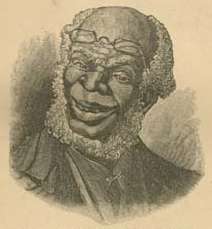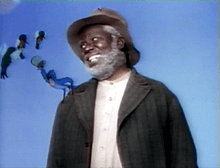Uncle Remus
| Uncle Remus | |
|---|---|
 | |
| First appearance | Uncle Remus, His Songs and His Sayings: The Folk-Lore of the Old Plantation |
| Created by | Joel Chandler Harris |
| Portrayed by | James Baskett (Song of the South) |
| Information | |
| Gender | Male |
Uncle Remus is the fictional title character and narrator of a collection of African-American folktales adapted and compiled by Joel Chandler Harris, published in book form in 1881. A journalist in post-Reconstruction Atlanta, Georgia, Harris produced seven Uncle Remus books. He wrote these stories to represent the struggle in the Southern United States, and more specifically in the plantations. He did so by introducing tales he had heard and framing them in the plantation context. He wrote his stories in a dialect that represented the voice of the narrators and their subculture. For this choice of framing, his collection has encountered controversy.[1]
Structure

Uncle Remus is a collection of animal stories, songs, and oral folklore, collected from southern African Americans. Many of the stories are didactic, much like those of Aesop's Fables and Jean de La Fontaine's stories. Uncle Remus is a kindly old freedman who serves as a storytelling device, passing on the folktales to children gathered around him.
The stories are written in an eye dialect devised by Harris to represent a Deep South Negro dialect. Uncle Remus is a compilation of Br'er Rabbit storytellers that Harris had encountered during his time at the Turnwold Plantation. Harris said that the use of the Negro dialect was an effort to add to the effect of the stories and allow the stories to retain their authenticity.[2] The genre of stories is the trickster tale. At the time of Harris's publication, his work was praised for its ability to capture plantation Negro dialect.[3]
Br'er Rabbit ("Brother Rabbit") is the main character of the stories, a likable character, prone to tricks and troublemaking, who is often opposed by Br'er Fox and Br'er Bear. In one tale, Br'er Fox constructs a doll out of a lump of tar and puts clothing on it. When Br'er Rabbit comes along, he addresses the "tar baby" amiably but receives no response. Br'er Rabbit becomes offended by what he perceives as the tar baby's lack of manners, punches and kicks it, and becomes stuck.[4]
Controversy and legacy
The animal stories were conveyed in such a manner that they were not seen as racist by many among the audiences of the time. By the mid-20th century, however, the dialect and the narrator's "old uncle" stereotype were considered demeaning by many African-American people, reflecting what they considered to be racist and patronizing attitudes toward African-Americans. Providing additional controversy is the stories' context, as they are set on a former slave-owning plantation and portrayed in a passive, even docile, manner. Nevertheless, Harris's work was, according to himself, an accurate account of the stories he heard from the slaves when he worked on a plantation as a young man. He claimed to have listened to, and memorized, the African American animal stories told by Uncle George Terrell, Old Harbert, and Aunt Crissy at the plantation; he wrote them down some years later. He acknowledged his debt to these storytellers in his fictionalized autobiography, On the Plantation (1892). Many of the stories that he recorded have direct equivalents in the African oral tradition.
Harris himself said, in the introduction to Uncle Remus, that he hoped his book would be considered:
...a sympathetic supplement to Mrs. Stowe's [author of Uncle Tom's Cabin] wonderful defense of slavery as it existed in the South. Mrs. Stowe, let me hasten to say, attacked the possibilities of slavery with all the eloquence of genius; but the same genius painted the portrait of the Southern slave-owner, and defended him.[5]
Mark Twain read the Uncle Remus stories to his children, who were awed to meet Harris himself. In his Autobiography Twain describes Harris thus:[6][7]
He was the bashfulest grown person I have ever met. When there were people about he stayed silent, and seemed to suffer until they were gone. But he was lovely, nevertheless; for the sweetness and benignity of the immortal Remus looked out from his eyes, and the graces and sincerities of his character shone in his face.
Twain wrote: "It may be that Jim Wolf was as bashful as Harris. It hardly seems possible...." Jim Wolf is a character from the first humorous story Twain ever told: "Jim Wolf and the Cats".
In modern-day times, African American mothers are known to read the Br’er Rabbit stories to their children to teach them about the significance of protecting the small from the big and the weak from the powerful.[8]
Adaptations in film and other media

Comics
An Uncle Remus and His Tales of Br'er Rabbit newspaper strip ran from October 14, 1945 through December 31, 1972.[9]
Films
The stories have inspired at least three feature films:
- The first and best known is Walt Disney's Song of the South (1946), a combination of live action and animation. Disney hired vaudeville and radio actor James Baskett to portray Remus, saying: "We want [the audience] to see 'Uncle Remus' and not some actor whose personality is already known to them through other screen roles." The appearance of Baskett, a large African-American man with a round face, contrasts with that of Uncle Remus in earlier book illustrations by Frederick S. Church, A. B. Frost, and E. W. Kemble.[10]
- Ralph Bakshi's film Coonskin (1975) is a satire of the Disney film that adapts the Uncle Remus stories to a contemporary Harlem setting.
- The Adventures of Brer Rabbit (2006) is a direct-to video production with hip-hop influences.[11]
Music
The song "Uncle Remus" was included on Frank Zappa's album Apostrophe (') (1974). The song co-written by Zappa and keyboardist/vocalist George Duke, tackled the subject of racial relations in America, and is something of a spiritual successor to “Trouble Every Day", a track on Freak Out! (1966) addressing similar issues. "Uncle Remus" is also mentioned as a character in "The Land of Make Believe" by Chuck Mangione (1973).
See also
References
- ↑ Montenyohl, Eric (1986). "The Origins of Uncle Remus". Folklore Forum. 18 (2): 136–167.
- ↑ Jim, Korkis (2012). Who's afraid of the Song of the South? : and other forbidden Disney stories. Norman, Floyd. Orlando, Fla.: Theme Park Press. ISBN 0984341552. OCLC 823179800.
- ↑ Clemens, Samuel L. (1883). "Chapter XLVII: 'Uncle Remus' and Mr. Cable". Life on the Mississippi.
- ↑ "Uncle Remus: His Songs and His Sayings". www.gutenburg.org. 2000-08-01. Retrieved 2010-05-25.
- ↑ Bernstein, Robin (2011). Racial Innocence: Performing American Childhood from Slavery to Civil Rights. New York: New York University Press. pp. 133–141. Provides more on the relationship between Uncle Remus and Uncle Tom's Cabin.
- ↑ Mark, Twain (1907). The North American Review - Chapters from My Autobiography. O. Everett. p. 329. Retrieved 29 July 2017.
- ↑ Twain, Mark (2013). Mark Twain Project :: Literary Works :: Autobiography of Mark Twain, Volume 2 : an electronic text. Retrieved 29 July 2017.
- ↑ Leslie, Annie Ruth (1997). "Brer Rabbit, a play of the human spirit: Recreating black culture through Brer Rabbit stories". The International Journal of Sociology and Social Policy. 17.
- ↑ "Disney's "Uncle Remus" strips". Hogan's Alley (16). 2009.
- ↑ Brasch, Walter M. (2000). Brer Rabbit, Uncle Remus and the "Cornfield Journalist": The Tale of Joel Chandler Harris. Mercer University Press. p. 275.
- ↑ "Child's Play". www.washingtonpost.com. 2006-04-09. Retrieved 2008-08-29.
Further reading
- "Joel Chandler Harris 1845 or 48 -- 1908". Eaton Literary Festival. Eatonton, Georgia. Short biography of Joel Chandler Harris with photograph
- Roosevelt, Theodore. "Theodore Roosevelt (1858–1919). An Autobiography. 1913 (Boyhood and Youth)". References in Theodore Roosevelt's autobiography to Brer Rabbit and Uncle Remus.
- "William Ruhlmann". AllMusic.
External links
| Wikisource has original text related to this article: |
| Wikimedia Commons has media related to Uncle Remus. |
- Full text of books by Uncle Remus from Project Gutenberg
- Official Uncle Remus Museum in Eatonton, GA
- Official Site of Uncle Remus
